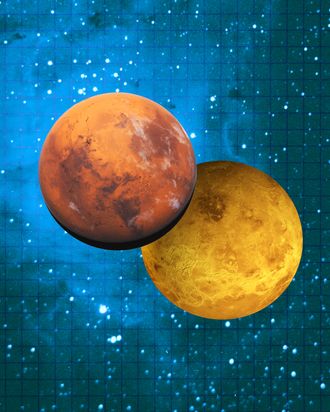
Ah, astrology and compatibility. It goes together like peanut butter and jelly. Harry and Meghan. Dating someone new and immediately spiraling. Astrology is an excellent tool to deepen self-awareness, recognize patterns, and catalyze deeper, more meaningful conversations. Dating, on the other hand, is bizarre, stressful, and filled with seemingly endless unknowns — so, in a sense, astrology offers the perfect antidote to the chaos of modern love.
The practice of mapping two charts and determining how they work together is called “synastry” — but how does it actually work? What should you look out for, and how do you know if something is written in the stars … or an absolutely dismal black hole? Read on for my time-honored compatibility tips and tricks.
Sun Signs
Sun-sign astrology — that is, astrology based solely on date of birth (as opposed to date, time, and location of birth needed to calculate a full natal chart) — is undeniably the most popular technique. It’s the root of most horoscopes, TikTok videos, and (unsurprisingly) the entry into romantic compatibility. Your sun sign is believed to represent ego, identity, personality, and preferences and, although it’s one small piece of a much more complex astrological puzzle, professional astrologers recognize the value of this placement. The sun is, after all, the brightest star in our sky: It’s how you shine, take up space, and radiate your unique magic.
When it comes to compatible signs, the most straightforward approach is through the elements. Fire signs (Aries, Leo, Sagittarius) are most compatible with other fire signs, as well as the air signs (Gemini, Libra, Aquarius). Earth signs (Taurus, Virgo, Capricorn) are most compatible with other earth signs, along with the water signs (Cancer, Scorpio, Pisces). Air signs are most compatible with other air signs as well as the fire signs, and water signs are most compatible with water and earth signs.
So when it comes to sun-sign compatibility, we can glean insight into how this couple exists externally. For instance, do these two people have fun in similar ways? Do they have similar approaches at parties? Do they have corresponding talents? Interests? Although the sun sign is not the be-all and end-all of astrological compatibility, it does answer one of the most fundamental questions: How do these two people get along?
Ascendant and Descendant
When we step beyond sun-sign astrology, we enter the wonderful (and, um, extremely complicated) world of birth charts. As a reminder, birth charts are plotted through date, time, and location of birth — I recommend calculating charts on TimePassages (available on both iOS and Android) or the website astro.com.
And when you get your chart and begin synthesizing all of the amazing planets and symbols and interpretations, be sure to pay extra attention to your rising sign. Also known as the ascendant, the rising sign reveals what zodiac sign was coming up (you know, rising) at the eastern horizon at your exact moment of arrival on earth. As one of the placements in your iconic “Big Three” (that’s how my fellow astrologer friends refer to their sun, moon, and rising), the rising illuminates your perception of reality, how you see the world, and the recurring themes that show up throughout your life. And yes, it plays a crucial role in compatibility.
As the ascendant represents your concept of “self,” the descendant (that is, the opposite sign of the ascendant, which was setting on the western horizon; the pairings are listed below for your easy enjoyment) symbolizes “other.” And not just any random “other” — the descendant is the entry point to the area of the chart (known as the seventh house) that’s associated with serious partnerships, long-term contracts, and even marriages. In short, the descendant reveals what we aspire to within a relationship.
- Aries Ascendant: Libra Descendant
- Taurus Ascendant: Scorpio Descendant
- Gemini Ascendant: Sagittarius Descendant
- Cancer Ascendant: Capricorn Descendant
- Leo Ascendant: Aquarius Descendant
- Virgo Ascendant: Pisces Descendant
- Libra Ascendant: Aries Descendant
- Scorpio Ascendant: Taurus Descendant
- Sagittarius Ascendant: Gemini Descendant
- Capricorn Ascendant: Cancer Descendant
- Aquarius Ascendant: Leo Descendant
- Pisces Ascendant: Virgo Descendant
At this point it should come as no surprise that one of my absolute favorite tips for assessing astrological compatibility is descendant compatibility. For instance, if you’re a Gemini ascendant, your descendant is Sagittarius. So if your partner has planets or points in Sagittarius, this would reflect strong compatibility because those Sagittarius placements are reflected as your “ideal.” What’s more, even if your partner doesn’t have planets in Sagittarius, someone with archetypical Sagittarian qualities (adventurous, philosophical, comedic) would also reflect top-notch compatibility.
Moon and Venus
Another lesser known but absolutely fabulous compatibility technique is noting the relationship between the moon and Venus. As the third and final placement in the Big Three, the moon represents your emotional world, along with your perception of safety and security. Considered one of the most private and sacred spaces in the birth chart, the moon shows your deep internal truth; how you genuinely feel about the world and your reality is embodied in this placement.
Venus, on the other hand, shows what you value. The planet of love and beauty, Venus is the romantic celestial body who adores all things romance. Within the birth chart, Venus reflects how you like to be wined and dined, as well as your personal taste, aesthetics, and perception of quality.
So if we know that the moon represents sensitivities and Venus symbolizes values, a couple that has strong moon-Venus compatibility (for example, one person’s moon sign is compatible with the other’s Venus, or vise versa; scroll up the sun-signs section for a refresher on compatible sign groups), this shows that there’s a positive flow between feelings and attraction. For instance, say you have a dreamy, creative, and intuitive Pisces Moon and your partner’s Venus is in a complimentary sign, like fellow water sign Scorpio: They’ll deeply appreciate your innate emotional sensibilities. Simply put, what one person needs to feel emotionally satiated is the exact type of energy the other person values. Now that’s amore!
Venus and Mars
Did you think I forgot sexual attraction? Never! Obviously, physical intimacy is a huge part of romantic relationships and, to glean insight on how two people connect sexually, we turn our attention over to Venus and Mars.
We now know that Venus is the planet of values, but we have yet to meet Mars, the small red planet associated with energy, momentum, and — naturally — libido. I like to say that Mars governs anything we thrust; accordingly, Mars in the birth chart reveals your approach to sex and sexuality, as well as what turns you on.
Strong compatibility between Venus and Mars (again, look at and compare the elements of the signs that these placements are in on your birth chart) shows a healthy flow between values and sexuality. For example, if you have a glamorous and regal Leo Venus, a partner with a complimentary Gemini Mars would be turned on by your feisty and charismatic nature — and you would, in turn, see their curious and playful Mars as an attractive, valuable asset. A sexy and dynamic duo … we love to see it!
More Astrology Explainers
- Get Ready for the Solar Eclipse in Aries to Change You
- A Guide to the Fire Signs: Aries, Leo, and Sagittarius
- How to Understand Every Zodiac Sign, by Element





